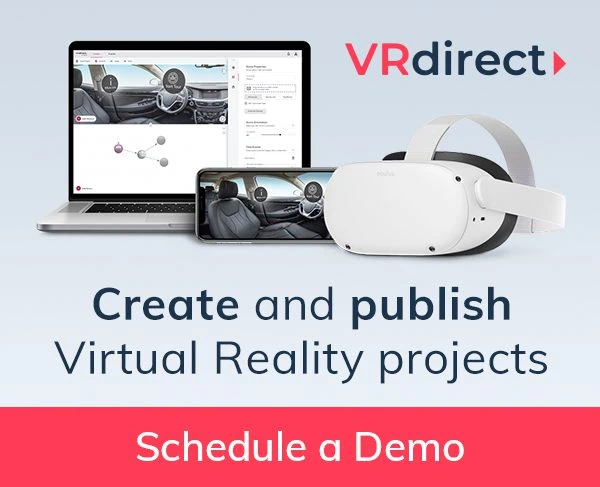Virtual Reality (VR) has opened up a new world of opportunities for businesses. Thanks to the dramatically improved availability of VR technology, as well as its decreased expense to implement, businesses are finding new ways to take full advantage of everything that Virtual Reality training tools have to offer.
Below we highlight some of the most significant benefits you will be able to enjoy when you dive headfirst into everything VR technology brings to the table!
Virtual Reality is more memorable
One of the main points of interest for many researchers looking into the effectiveness of Virtual Reality experiences in company training is the memorability in comparisons to other media like video or text.
Ever since 1991 multiple studies have shown that VR experiences offer a better memorability. This, for example, is caused by the dynamic change of the presented environment following the movements of the user which other media can’t offer. This multi-sensory and emotional input results in higher memorability of a VR experience. (Clark & Paivio, 1991)
These findings are supported by the research of Schöne et al. from the year 2017. In their study participants were presented with either a 360° VR or 2D video of a motorcycle ride followed by an unannounced recognition memory task 48 hours later. The results were clear: increased retrieval success and delayed reaction times in the VR group indicate that immersive VR experiences become part of an extensive autobiographical associative network, whereas the traditional video experience remains an isolated episodic event. That means the Virtual Reality experience felt like something that happened to them rather than just a memory of a video of something that happened to someone else. In fact, the subjects who trained with Virtual Reality video performed twice as well on the memory retrieval tests. (Schöne et al., 2017)
In other words: the high level of realism and immersion that Virtual Reality experiences offer increases memory retention and recollection of subjects and by that it increases the chances that the learning experience can be transferred and utilized in a real-world environment. Companies should leverage this knowledge and – instead of falling back into old patterns – create immersive and interactive VR experiences for their company training.

Reduction of fear and stress
Another application that made Virtual Reality somewhat popular is its use in medicine to treat phobias or stress disorders. A lot of research has been conducted on its effectiveness, and again the findings are clear: the immersive nature of VR experiences allow for repeated and controlled exposure to emotional stimuli in a safe condition. Over time this reduces the stress or fear response to those stimuli.
The use of Virtual Reality in such a scenario has many different advantages. For example, subjects can be presented with 3D- and interactive stimuli that would be difficult to represent otherwise (like talking in front of a big audience) and these stimuli can be controlled, repeated and adjusted according to the subject easily (for example by gradually increasing the audience size).
(e.g. Rizzo et al., 2014, Bohill et al., 2011)
Again companies can use this knowledge to improve their training. CEOs could train to give keynote talks in front of big audiences and customer representatives could practice being confronted by angry or difficult customers, while learning to remain calm. HR staff could improve their skills to mediate conflicts between employees.
VR experiences provide the ability to train employees that was previously only possible through repeated experience or specialized and expensive in-person training.
Isolation from distractions
In today’s world, nothing seems to happen undistracted or uninterrupted. Even in highly focussed working situations Facebook and Instagram are just one mouse-click away and smartphones are always within an arms reach. A study by Vouchercloud.com shows that in an 8-hour day, the average worker is productive for only 2 hours and 53 minutes.
The top 10 unproductive activities include:
- Checking social media – 47% (44 minutes, spent doing this during working day).
- Reading news websites – 45% (one hour and five minutes).
- Texting and instant messaging – 27% (14 minutes).
Many companies offer e-learnings or something similar that takes place on the smartphone or computer of the employee. By doing that, the company has no control over the distractions and other pursuits of the training subject, which is entirely different in a Virtual Reality training situation. By providing a sensory-rich experience in a VR headset, the focus of the employee will always remain on the content of the experience and therefore, without a doubt, increases the effect of the provided training method. Learn how Siemens trains its employees in Virtual Reality here.
Elimination of Risks
Another considerable advantage of VR training has to be the fact that companies can manage and mitigate risk in ways that aren’t possible when you are training in the real world.
NASA astronauts use VR technology throughout their training, providing them with an ability to go through their entire mission into space – from start to finish – without ever having to leave the confines of Cape Canaveral or any of the other NASA installations.
Read our article about Virtual Reality Safety Training and learn how you can minimize risks.
Okay – not every company has to send someone to space – but let’s break this down: because VR tools are so advanced, it’s possible to create unique situations that perfectly mimic the real world. Companies can put trainees through their paces without ever having to risk their health or well-being, and also won’t have to worry about risking a tremendous amount of capital should something go belly up on a real-world training exercise for example when training with new machines or familiarizing your employees with a new facility floor and potential health hazards. Additionally, emergency and evacuation procedures can finally be trained in a realistic setting.
Save Money
Many people have the misconception that VR training is more expensive than real life or traditional media company training. After all, you have to create a realistic 3D-environment or spend thousands of dollars to create 360° video. Afterward, you have to add interactive elements with coding and the use of advanced programming techniques and the deployment on your companies smartphones or is another huge expense. Right? Wrong!
VR training is not what it used to be when it comes to price. The technology has advanced by light years but simultaneously got more affordable.
High quality 360° cameras are available all over the place for a few hundred dollars – and even if you want to go stereoscopic and very high quality you can find cameras for a few thousand dollars. You will find a complete shopping guide here.
Tools like our VRdirect Studio allow companies to add interactive elements without the need for any coding skills. And the deployment of your interactive VR experience on all common devices and platforms (like iOS, Android or Pico) comes out of the box with the VRdirect Studio as well.
Thanks to the proliferation of devices like Pico Neo 3, for example, as well as dramatic upgrades to smartphones, tablets, and desktop computers you can send an entire VR training platform over the internet to any different number of devices and have your trainees open them – and interact with them.

Conclusion
So what does this mean in a nutshell: instead of having to bring all your employees to one physical location to train them or provide them with costly training materials like e-learnings, brochures and webinars that have to be created by costly agencies, companies can now create and publish their own interactive Virtual Reality projects easily and cost-efficient. VRdirect is a perfect tool that can easily and fully be integrated in internal company workflows without the need for additional staff.The Vrdirect Studio is usable by drag and drop and the usage is so intuitive you can create interactive 360° training experiences within minutes. We have created a complete tutorial on how to use our Studio so you can convince yourselves.
VRdirect allows companies to quickly edit, push updates, and overhaul VR projects digitally without having to bring everyone together to download the latest version of the VR training you have created. In other words: VRdirect allows for real time content updates, which often is key for employee training especially if the content updates frequently.
This makes Virtual Reality very suitable for companies with a lot of employees in various locations as well. May it be telecommunication companies, supermarket chains, transportation or logistics services, cinemas, auto repair chains. Just to name a few.
Virtual Reality technology is very much the future of our business world and it would be a mistake to ignore the potential that it already offers, as well as the opportunity to get in on the ground floor of this emerging technology before the competition does.
Virtual Reality training offers a significant competitive advantage for those that are quick moving and forward thinking, and smart and savvy businesses and organizations the world over are already diving headfirst into everything that VR has to offer.
Take a test drive with the VRdirect Platform today and get a feel for just how simple, straightforward, and how impactful Virtual Reality tools can be for your operation firsthand!
Literature:
Bohil, C. J., Bradley, A., Biocca, F. A. (2011). Virtual reality in neuroscience research and therapy. Nature Reviews: Neuroscience, 12, 752-762.
Clark, James M., and Allan Paivio. “Dual coding theory and education.” Educational psychology review 3.3 (1991): 149-210.
Rizzo, A. A., Schultheis, M., Kerns, K. A., & Mateer, C. (2004). Analysis of assets for virtual reality applications in neuropsychology. Neuropsychological Rehabilitation, 14(1-2), 207–239.
Schöne, Benjamin, Marlene Wessels, and Thomas Gruber. “Experiences in virtual reality: A window to autobiographical memory.” Current Psychology (2017): 1-5.
Media: Shutterstock.com





